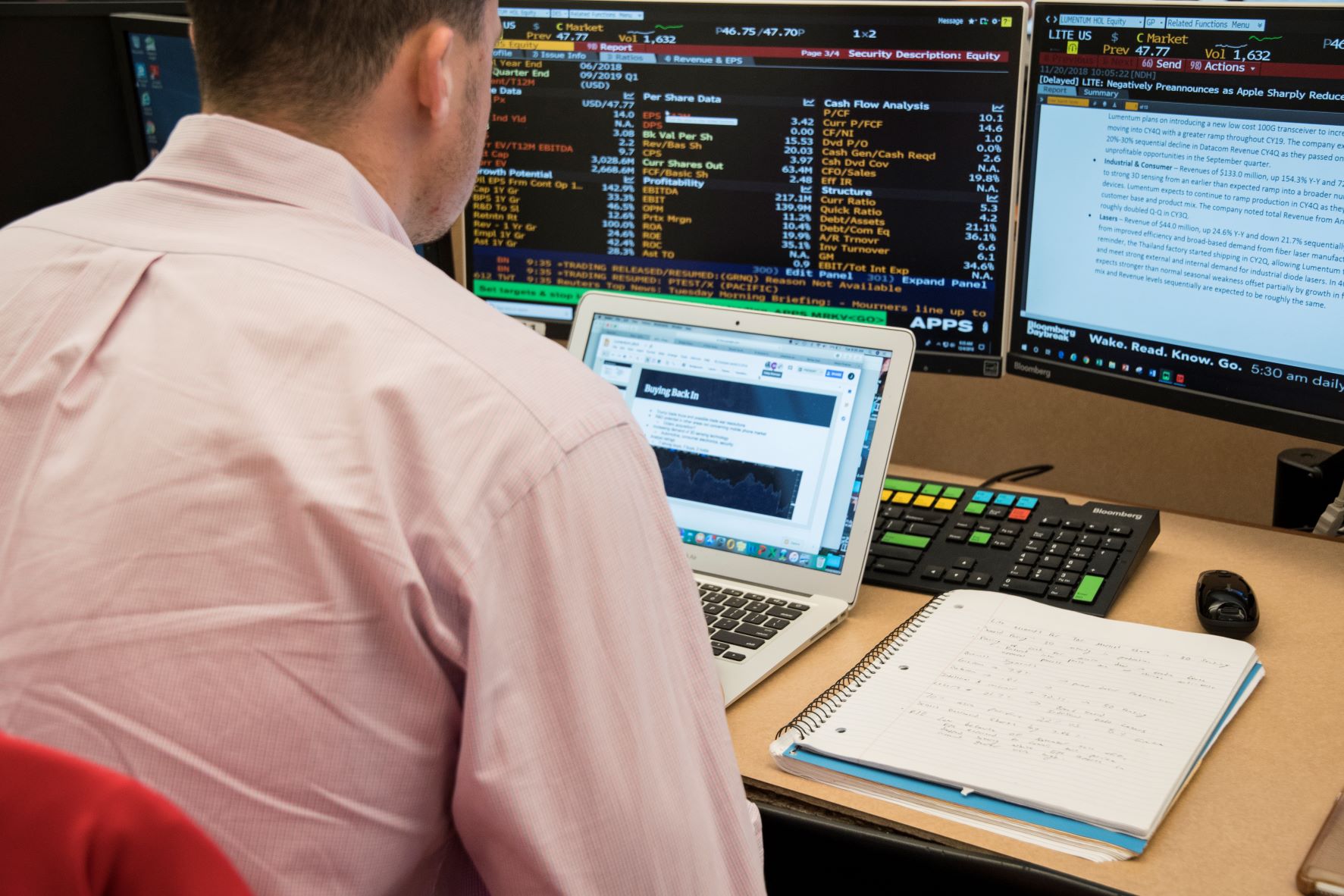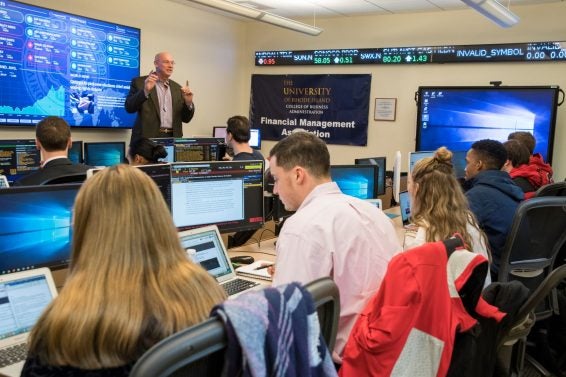Reaching a Milestone: The Ram Fund Celebrates 20 Years of Success

Over the last 20 years, nearly 500 talented and dedicated students have been a part of the Ram Fund, which boasts a current portfolio value of $850,000. In 2020, the URI Ram Fund was ranked tops by the Quinnipiac GAME Forum for its 52% investment return, beating out over 150 student-managed funds from around the globe.
It was a novel idea. A risky idea. Allow students to manage an investment fund with real capital within an environment that mimics the demands and pressures of an investment management firm. But it was just the kind of big idea that the URI College of Business needed in 2001 to take it to the next level.
The Ram Fund, as it’s known today, is URI’s student-managed investment fund. “It is the purest form of experiential learning possible. It takes the top 15 students, puts them in the roles of analyst, portfolio manager, and fiduciary and entrusts them to manage real capital,” says Professor Michael Ice, who co-leads the Ram Fund with Professor Deborah Imondi ’82, Executive MBA ’86.
Now in its 20th year, the program has experienced tremendous success in terms of investment returns, student development, and alumni engagement.
The program originated from a proposal developed in 2001 by Dennis McLeavey, professor emeritus of finance. “Through the Chartered Financial Analyst program, I came to learn of other student-managed funds at schools across the country and how they were able to successfully implement concepts from the CFA program,” said McLeavey. “I knew we needed to be competitive amongst our peer schools as well as give these students the tools needed to be attractive to employers. This was a perfect way to do just that.”
There was just one impediment. Where would the start-up funds come from? McLeavey, along with others, presented the URI Alumni Board with a proposal that requested the initial capital. The board enthusiastically supported the idea.
“The board believed that our business students had the intelligence and were developing the skills needed to successfully manage a portion of the Alumni Association’s investment portfolio under the guidance of Professor McLeavey,” said Peter Miniati, who at the time served on the Alumni Board and its finance subcommittee. “We were initially concerned about the inexperience of our students but that was offset by their motivation and intelligence.”
With $100,000 of the Alumni Association’s long-term investment funds, the program launched in the fall of 2001 under the direction of Keith Moore, ’74, PhD ’04. Moore had returned to URI for a four-year doctoral program and was asked by Dean Ed Mazze to lead the initiative.
Moore noted, “Everyone in the Dean’s office, the Alumni Office, professors, and the students were extremely excited about the fund’s prospects. It was such an incredible opportunity to provide the students with real-life money management and investment experience that would build their skills, enhance their résumés, and give them a competitive edge in the job market.”
The first step was to establish the rules. They needed to determine the proper structure and policies that would balance the rewards with the risks. A group of 10 students was convened and, under the guidance of Moore, they laid the foundation for what became the Ram Fund.

Aaron Lewis, a member of the 2001 Ram Fund class, remembers, “My classmates and I were looking to gain some real-life experience with investing, and this was the perfect opportunity.”
That December, the fund faced its first challenge. In the fall, one of the students had researched and recommended the purchase of stock in Enron. But as the Enron scandal came to light, students proposed voting on the sale of the Enron holding, which failed by one vote. Conversations outside the classroom among students resulted in a second vote about a week later. That vote passed.
“Over the four years that I taught the Ram Fund, this was one of the most defining moments,” said Moore. “I was so relieved [after the second vote] that I left them to discuss another investment and ran across the Quad to get the trade executed.”
Within a week Enron’s stock totally collapsed. “I tried to teach them earlier that buying is usually easier than the decision to sell,” added Moore. “I think they learned that concept very well with the Enron experience.”
In 2003, Ballentine Hall underwent a significant renovation. Bruce Sherman ’63, one of the country’s top money managers, made a $250,000 gift to establish a stock trading room The room was named the Bruce S. Sherman Trading Room in his honor, and it became the official home of the Ram Fund. In addition, Richard Harrington, president and chief executive officer of The Thomson Corp., contributed $100,000, and he and his company donated Thomson One, the leading financial analysis database in the world, for the trading center.
“I was on campus recently and was blown away by the investments the university has made in architecture and technology. The trading floor they’ve created has the look and feel of those I’ve worked on throughout my career and it’s great to see that students can get that same experience,” noted Lewis (who now serves as the Global Markets Business Development Manager at Citizens Commercial Banking).

The 2008 global financial crisis was a defining moment for the Ram Fund. The fund sank to about $80,000, after being at almost $120,000 at one point, said Professor Peter Dadalt, who taught the class from 2007-2015. However, the students remained focused and maintained the portfolio’s long-term investment strategy.
“The next few years saw the fund gain back all the losses and more,” he said. “The students were the cream of the finance crop. They were motivated, enthusiastic and in love with the topic. Many of them obtained their CFA charters and have had successful careers in finance.”
In 2020, the pandemic hit, students were not allowed to return to campus, and the economy and markets were in a freefall. “These were unprecedented times even for those of us who have been around for some time,” said Ice.
But the students did not panic. Through conference calls, the students diligently rebalanced the portfolio using Exchange Traded Funds to respond to the economic environment. They willingly extended their semester a few weeks to get the portfolio in a position to weather the summer and preserve capital until the next class in the fall would take over. The low was March 20, 2020, with the fund at $317,987.88. But under the guidance of URI students the portfolio is now up approximately 270%, to $855,048.00.
Twenty years after the establishment of the Ram Fund, it is still going strong, training future leaders, and earning positive returns for the URI Foundation & Alumni Engagement.
Nearly 500 talented and dedicated students have gone through the program and the portfolio is valued at over $850,000. Further, in 2020, the URI Ram Fund was awarded the #1 Core Portfolio by Quinnipiac GAME Forum for its 52% return for 2020, beating out over 150 student-managed funds from around the globe.
“I truly believed the Ram Fund would have the success it has had. Students would gain practical experience and job opportunities would flow to students as they implemented the CFA approach to risk and return,” said McLeavey.
“I look back at my experiences with Ram Fund as one of the most important highlights of my career both in business and academia,” Moore remarked.
Ram Fund alumni have gone on to become incredibly successful individuals, employed by top firms around the world. They are staying connected with URI by mentoring and hiring current students. “We are so proud of our investment industry leaders who return to Kingston to share their knowledge and career insight with undergrads and give back to URI and the College of Business, with their expertise and their time and treasure,” said Miniati.
As for the future of the Ram Fund?
“Financial education is not just about the theory; it needs to seamlessly combine the best practice with the latest development in theory,” noted Professor Bing-Xuan Lin, the current finance area coordinator. “We will continue to deliver on the Ram Fund’s core objective proposed 20 years ago — to provide an unparallel experiential learning opportunity that equips students with the knowledge and skills to succeed.”
One of the focuses is to encourage participation from a more diverse student body, Lin said. Significant resources, including funds from a gift from Margo Cook ’86, have been invested to promote women in finance and to attract more women students to study finance. The Ram Fund gives students greater self-confidence in their ability to master the world and will continue to develop the most talented and self-motivated individuals in the College of Business.
